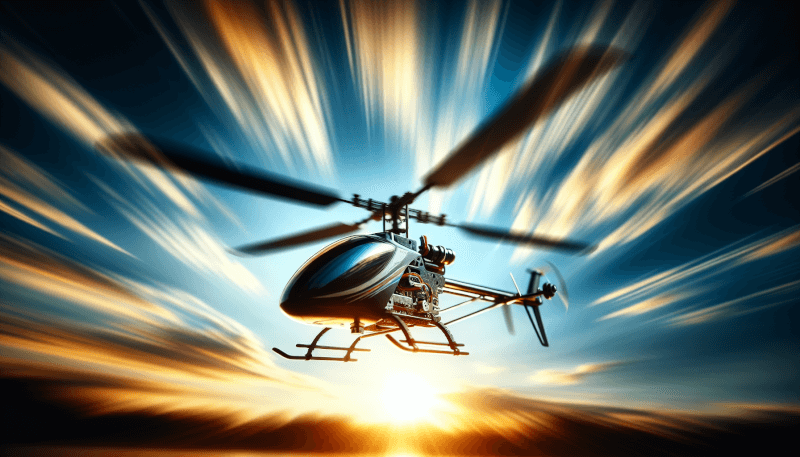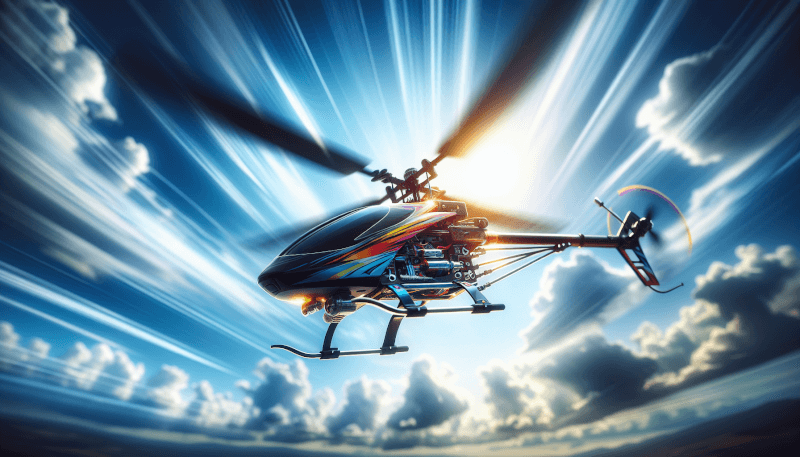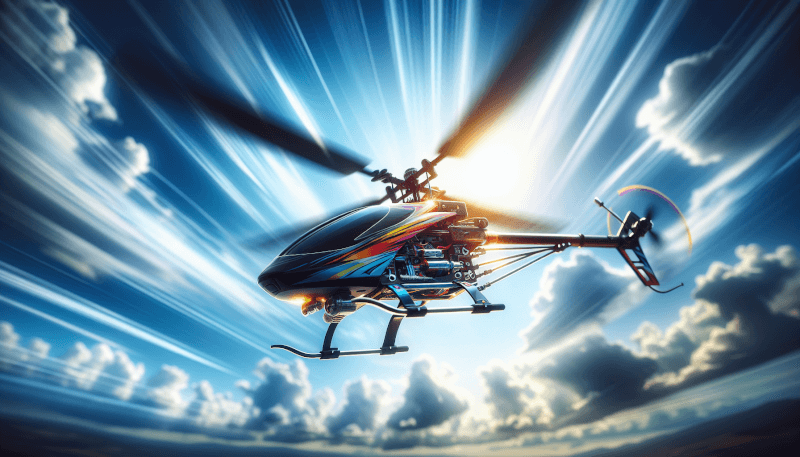Are you fascinated by the thrilling world of RC helicopters but worried about crashing them? Look no further! In this article, you will discover the best strategies to learn how to fly an RC heli without any accidents. Whether you are a beginner or have some experience, these tried and tested methods will help you master the art of flying with confidence and ease. So, get ready to take to the skies and enjoy the exhilarating adventure of RC helicopter piloting!

Finding the Right RC Heli
Choosing the right type of RC heli
When starting out in the world of RC helis, it’s important to choose the right type of heli that suits your interests and goals. There are various types to choose from, such as collective pitch helis, coaxial helis, and fixed pitch helis. Each type has its own characteristics and flying experience. Researching and understanding the differences between these types will help you make an informed decision and ensure that you enjoy flying your RC heli.
Considering your skill level
Before investing in an RC heli, it’s crucial to assess your skill level. If you’re a beginner, it’s recommended to start with an entry-level heli that is designed for beginners. These helis usually have stability features and are forgiving of pilot errors. As you gain more experience and confidence, you can then progress to more advanced helis that offer greater maneuverability and performance. Matching your skill level with the appropriate heli will make the learning process smoother and more enjoyable.
Researching different models
Once you’ve determined the type and skill level of the heli you want, it’s time to delve into the world of RC heli models. Researching different models will allow you to compare their features, specifications, and performance capabilities. Look for reviews, forums, and online communities where experienced pilots share their insights and experiences with different models. This research will help you find the best RC heli that meets your needs and preferences.
Seeking guidance from experts
If you’re new to RC helis, seeking guidance from experts can significantly accelerate your learning process and help you avoid common pitfalls. Reach out to experienced pilots at your local RC heli club or online forums. They can provide valuable advice, tips, and recommendations based on their own experiences. By learning from those who have already mastered the art of flying RC helis, you can save yourself time, frustration, and unnecessary crashes.
Investing in Quality Equipment
Importance of quality transmitter and receiver
Investing in a quality transmitter and receiver is crucial for a smooth and reliable RC heli flying experience. These components serve as the communication link between you, the pilot, and your heli. Look for transmitters and receivers that offer a good range, multiple channels, and reliable signal transmission. A high-quality transmitter will give you precise control over your heli, enhancing your overall flying experience.
Choosing the right battery
The battery is the lifeblood of your RC heli, providing the power needed to keep it airborne. When choosing a battery, consider its capacity, voltage, and weight. A battery with higher capacity and voltage will generally provide longer flight times and better performance. However, be mindful of the weight, as a heavier battery can affect the heli’s maneuverability. Investing in high-quality batteries from reputable manufacturers will ensure better power output and longevity.
Investing in a good simulator
One of the best investments you can make as an aspiring RC heli pilot is a good simulator. Flight simulators allow you to practice flying in a virtual environment, replicating the real-life experience without the risk of crashing. They offer a safe platform to hone your flying skills, experiment with different maneuvers, and build muscle memory. Look for simulators that have realistic physics and a wide range of heli models to choose from.
Getting the necessary tools and spare parts
Being prepared for any eventuality is essential when it comes to flying RC helis. It’s important to have a set of tools specifically designed for RC heli maintenance and repairs. These tools will come in handy when you need to make adjustments, fix minor issues, or replace parts. Additionally, having a stock of spare parts, such as rotor blades, tail booms, and landing gear, will ensure that you can quickly get back in the air after a crash or component failure.
Understanding the Basics
Learning about the controls
Before you take to the skies, it’s crucial to have a solid understanding of the basic controls of an RC heli. Familiarize yourself with the functions of the various control surfaces, such as the cyclic, collective pitch, throttle, and tail rotor. Spend some time studying the transmitter, understanding how each stick and switch corresponds to the movement of your heli. Practice these controls in a safe and open area until you develop muscle memory and confidence.
Understanding aerodynamics of helis
To become a skilled RC heli pilot, it’s important to grasp the basic principles of aerodynamics. Understanding how the different control surfaces impact the flight characteristics of your heli will help you make precise maneuvers. Learn about concepts such as lift, drag, torque, and gyroscopic precession. Building a foundation of knowledge in aerodynamics will allow you to make informed decisions while flying and troubleshoot any issues that may arise.
Practicing throttle control
Mastering throttle control is a fundamental aspect of flying RC helis. The throttle controls the power output of the motor and, consequently, the altitude and speed of your heli. Practice adjusting the throttle smoothly, maintaining a steady hover, and controlling the ascent and descent of your heli. Developing good throttle control will enable you to maintain stability and fly with precision, even in challenging conditions.
Mastering hovering and altitude control
Hovering is the foundation of flying RC helis and a skill that every pilot must master. Learning to keep your heli stable and steady in mid-air is essential for performing more advanced maneuvers. Spend time perfecting your hovering skills, maintaining a consistent altitude, and making tiny adjustments to counteract any drift or unwanted movement. With practice, you’ll gain the ability to effortlessly control your heli’s position, making it easier to transition into more complex flight patterns.
Joining an RC Heli Club
Benefits of joining a club
Joining an RC heli club can be immensely beneficial for both new and experienced pilots. Clubs provide a supportive community where enthusiasts can share their passion for RC helis. By joining a club, you gain access to a wealth of knowledge, experience, and resources that can help you improve as a pilot. You’ll have the opportunity to meet like-minded individuals, collaborate on projects, and engage in friendly competitions and events.
Learning from experienced pilots
One of the biggest advantages of joining an RC heli club is the opportunity to learn directly from experienced pilots. Seasoned pilots can offer valuable guidance, tips, and tricks that they’ve acquired through years of flying. They can help you troubleshoot any issues, provide feedback on your flying techniques, and suggest ways to improve your skills. Learning from those who have already overcome common challenges will save you time and frustration.
Taking advantage of club resources
RC heli clubs often have a wide range of resources that can enhance your flying experience. Many clubs have dedicated flying fields or designated areas where you can safely fly your heli without interference. They may also have access to specialized equipment, such as tools, charging stations, and even simulators. Taking advantage of these resources can save you money in the long run and provide a supportive environment for learning and practicing.
Building a network of fellow enthusiasts
Joining an RC heli club is not just about improving your flying skills; it’s also about building connections and friendships with fellow enthusiasts. Being part of a network of people who share your interests can be incredibly rewarding. You can exchange ideas, experiences, and even borrow or trade equipment. The RC heli community is known for its camaraderie and willingness to help each other, so don’t hesitate to get involved and make new friends along the way.

Starting with Flight Simulators
Benefits of using flight simulators
Flight simulators are an invaluable tool for RC heli pilots of all skill levels. They offer a safe and risk-free environment to practice and hone your flying skills. Simulators allow you to learn and experiment with various maneuvers, perfecting them before attempting them in real life. They provide instant feedback on your performance and allow you to analyze and correct any mistakes. Using a flight simulator can significantly reduce the risk of crashes and accelerate your learning progress.
Choosing the right simulator software
When selecting a flight simulator, it’s important to choose software that suits your needs and preferences. Look for simulators that have realistic physics, accurate control responses, and a wide range of heli models to choose from. Consider compatibility with your computer or gaming system, as well as any additional peripheral devices you may want to use, such as a dedicated RC heli controller. Reading reviews and seeking recommendations from experienced pilots can help you make an informed decision.
Practicing various flight maneuvers
Flight simulators provide a safe and controlled environment to practice a wide range of flight maneuvers. Start with basic maneuvers, such as takeoffs, landings, and hovering, and gradually progress to more complex maneuvers, such as loops, rolls, and inverted flight. Practice autorotations, emergency landings, and recovery techniques to build your confidence and ability to react in different scenarios. Flight simulators allow you to repeat maneuvers and perfect them until they become second nature.
Utilizing simulator controller peripherals
To enhance the realism and precision of your simulation experience, consider investing in dedicated RC heli controller peripherals. These peripherals mimic the look, feel, and functionality of a real RC heli transmitter, providing a more immersive experience. They often offer extra features, such as adjustable tension on the control sticks and additional switches for programming different flight modes. Using these peripherals will help you develop muscle memory and make the transition from simulator to real-life flying smoother.
Seeking Professional Instruction
Importance of professional guidance
While simulators and online resources are valuable tools for learning to fly RC helis, nothing beats the expertise and personalized instruction of a professional. Seeking professional guidance ensures that you learn the correct techniques right from the start and develop good habits. Professional instructors can identify and correct any mistakes or bad habits early on, preventing them from becoming ingrained. They provide individualized feedback and guidance tailored to your specific needs and goals.
Finding a reputable instructor or flight school
When looking for professional instruction, it’s essential to find a reputable instructor or flight school with a proven track record. Seek recommendations from fellow RC heli pilots or local RC heli clubs. Research the instructors’ qualifications and experience in teaching RC heli flying. Look for positive reviews and testimonials from past students. A good instructor will have the patience, knowledge, and ability to adapt their teaching style to match your learning pace and style.
Getting personalized feedback and tips
The advantage of learning from a professional instructor is the personalized feedback and tips you receive. They can identify any areas where you may be struggling or making mistakes and provide targeted guidance for improvement. They can introduce you to advanced techniques and help you perfect your flying skills. By tailoring their instruction to your specific needs, a professional instructor can help you progress at a faster rate and achieve your goals more effectively.
Overcoming challenges with expert assistance
RC heli flying can present unique challenges, especially when it comes to troubleshooting issues and overcoming difficult maneuvers. A professional instructor can guide you through these challenges and provide strategies for overcoming them. Whether it’s dealing with technical malfunctions, flying in adverse weather conditions, or performing advanced aerobatics, an experienced instructor has the knowledge and expertise to help you navigate these challenges safely and effectively.

Gradual Progression and Patience
Taking gradual steps in learning
Learning to fly RC helis is a gradual process that requires patience and practice. It’s important to take small, incremental steps and gradually build on your skills and knowledge. Start with simple maneuvers and gradually increase the difficulty as you become more comfortable and confident. Trying to rush the learning process by attempting advanced maneuvers too soon can result in crashes and frustration. By taking your time and focusing on gradual progression, you’ll build a strong foundation for more complex flying in the future.
Staying patient with the learning curve
Flying RC helis can be challenging, especially in the beginning. It’s essential to stay patient and not get discouraged by initial difficulties. Learning to fly requires time, effort, and persistence. Expect to make mistakes and have crashes along the way. Embrace these experiences as opportunities for growth and learning. With each mistake and crash, you’ll gain valuable insights and learn what not to do. Remember that every successful flight is a result of the patience and perseverance you’ve invested.
Avoiding rushing into complex maneuvers
While it may be tempting to dive into advanced maneuvers and tricks, it’s important to resist that temptation until you have acquired the necessary skills and experience. Complex maneuvers require precise control and a deep understanding of your heli’s capabilities. Rushing into advanced flying without the proper foundation can lead to crashes and setbacks. Focus on mastering the basics and gradually introduce more complex maneuvers once you have built a solid skill set.
Building confidence with small achievements
Building confidence is an essential aspect of learning to fly RC helis. Celebrating small achievements along the way will keep you motivated and boost your confidence. Set achievable goals for each flying session, such as completing a smooth takeoff or landing, maintaining a stable hover, or executing a basic maneuver. As you consistently achieve these goals, your confidence will grow, and you’ll be more willing to take on new challenges. By acknowledging your progress and embracing small victories, you’ll stay motivated and enjoy the learning process.
Developing Safe Flying Habits
Understanding safety guidelines and rules
Safety should always be a top priority when flying RC helis. Familiarize yourself with the safety guidelines and rules established by regulatory bodies such as the Academy of Model Aeronautics (AMA) or your local aviation authority. Understand the limitations and requirements for flying in different areas, such as parks or designated flying fields. Observe proper etiquette and respect the space and privacy of others. By adhering to safety guidelines, you protect yourself, others, and the reputation of the RC heli community.
Inspecting heli and equipment before every flight
Performing pre-flight inspections is a crucial habit that every RC heli pilot should develop. Before each flight, thoroughly inspect your heli and equipment for any signs of damage, loose components, or malfunctions. Check the rotor blades, tail assembly, electronics, and other critical components. Ensure that all bolts, screws, and connectors are secure. Pay close attention to the battery and its connectors for any signs of wear or damage. A thorough inspection minimizes the risk of in-flight failures or accidents caused by equipment issues.
Practicing safe flying locations and altitudes
Choosing safe flying locations and altitudes is essential to ensure the safety of yourself and others. Fly in designated flying areas or open spaces away from people, buildings, and power lines. Avoid flying near airports or restricted airspace. Be mindful of other pilots and their potential blind spots. Respect local noise regulations and be considerate of the surrounding environment and wildlife. By practicing safe flying habits, you contribute to a positive and responsible RC heli flying community.
Maintaining situational awareness at all times
Maintaining situational awareness is critical for safe and enjoyable RC heli flying. Be aware of your surroundings, including other helicopters, pilots, and potential obstacles. Keep an eye on your heli’s battery life, as running out of power mid-flight can result in a loss of control. Stay vigilant for changes in weather conditions, such as wind speed or precipitation, that may affect your flying capabilities. By staying alert and aware, you can anticipate and react to potential risks or challenges, ensuring a safer flying experience.

Learning from Mistakes and Crashes
Accepting that crashes are part of learning
As much as we strive to avoid them, crashes are an inevitable part of learning to fly RC helis. Accepting this fact from the beginning will help you maintain a positive mindset and not get discouraged when accidents occur. Crashes provide valuable learning opportunities, allowing you to analyze what went wrong and make adjustments for future flights. Embrace crashes as lessons rather than failures and use them as stepping stones on your journey to becoming a skilled RC heli pilot.
Analyzing crash causes and learning from them
After a crash, it’s important to take the time to analyze the causes and learn from them. Examine the flight conditions, your inputs on the controls, and the behavior of the heli leading up to the crash. Identify any mistakes or errors in your flying techniques. Determine if any equipment failures or malfunctions contributed to the crash. By thoroughly analyzing each crash, you’ll be able to avoid repeating the same mistakes and improve your flying skills.
Investigating equipment failure possibilities
In some cases, crashes may be caused by equipment failures or malfunctions. It’s important to investigate and determine if any equipment issues were a contributing factor. Inspect the heli and all its components for signs of damage or wear. Check the battery, connectors, servos, and any other critical parts. If necessary, consult with experienced pilots or professionals to help identify any equipment failures. Taking precautions to prevent future crashes caused by equipment failures is essential for safe and reliable flying.
Taking precautions to prevent future crashes
Learning from crashes is not just about analyzing the causes but also taking proactive measures to prevent future accidents. Implement any necessary repairs or replacements to ensure your heli is in optimal condition. Double-check your pre-flight inspection procedures and ensure they are thorough. Continuously improve your flying techniques, focusing on areas where you made mistakes. By actively working to prevent future crashes, you’ll become a more skilled and confident RC heli pilot.
Continual Learning and Improvement
Continuously expanding flight repertoire
Learning to fly RC helis is an ongoing journey of growth and improvement. As your skills and confidence grow, it’s important to continuously expand your flight repertoire. Gradually introduce new maneuvers, such as rolls, loops, and inverted flight. Challenge yourself to fly in different weather conditions or with limited visibility. Experiment with different flight patterns and techniques. By pushing your boundaries and trying new things, you’ll become a more versatile and experienced RC heli pilot.
Experimenting with new maneuvers and tricks
Once you have mastered the basics, don’t be afraid to branch out and experiment with new maneuvers and tricks. Research and learn about advanced aerobatics and acrobatic maneuvers, such as tic-tocs, piro flips, and hurricanes. Make sure to practice these maneuvers in a safe and open area, gradually building your confidence and proficiency. Experimenting with new maneuvers will not only make flying more exciting but also challenge your skills and push your limits as a pilot.
Staying updated with latest RC heli technologies
The field of RC helis is constantly evolving, with new technologies and innovations being introduced regularly. Stay updated with the latest advancements in RC heli technologies, such as improved flight controllers, brushless motors, and more efficient batteries. Follow reputable RC heli manufacturers, read industry news, and participate in online forums and communities to stay informed. Understanding and embracing new technologies can enhance your flying experience and open up new possibilities for exploration and enjoyment.
Attending workshops, events, and competitions
Attending workshops, events, and competitions is a great way to further your learning and connect with fellow RC heli enthusiasts. Workshops and seminars provide opportunities to learn from experts, acquire new skills, and gain insights into advanced flying techniques. Events and competitions allow you to showcase your skills, receive feedback from experienced judges, and observe other talented pilots in action. Participating in these activities enhances your overall flying experience and fosters a sense of community and camaraderie among RC heli pilots.
In conclusion, learning to fly RC helis is an exciting and rewarding journey that requires patience, practice, and continuous improvement. By finding the right RC heli, investing in quality equipment, understanding the basics, joining an RC heli club, starting with flight simulators, seeking professional instruction, embracing gradual progression and patience, developing safe flying habits, learning from mistakes and crashes, and continually learning and improving, you’ll be well on your way to becoming a skilled and confident RC heli pilot. So get out there, enjoy the thrill of flying, and have fun exploring the endless possibilities that the world of RC helis has to offer!



